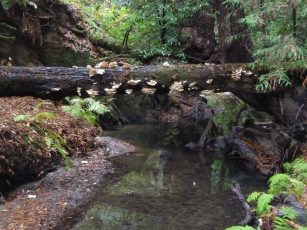
I’ll bet if you walk around your yard you’ll find mushrooms poking through the soil under trees, between shrubs, even next to the driveway. This has been a banner year for fungi as early rains then mild weather helped make our local fungi very happy. The edible ones are one of the most nutritious foods in the world, packed with antioxidants. Without fungus, we?d have no bread, cheese, beer or wine. Fortunately, I have a friend who is takes their identification very seriously and finds lots of delicious types on his mountain biking ventures and he likes to share. Thank you, Robby.
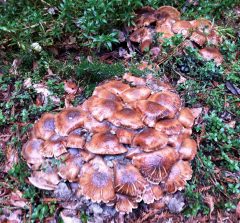
The same cluster of dark brown mushrooms has come up again just outside my back door. Could they be edible? Might I be able to try out one of those delicious sounding recipes in my “Gourmet’s Guide to Mushroom Cookery”?
While there are many wild mushrooms growing in this area that are edible there are just as many that are poisonous. Mistakenly ingesting them can cause death or liver damage so severe that a transplant would be needed for you to survive. In November, Santa Cruz County received the second report of a hospitalized person who became seriously ill after eating mushrooms collected in the La Selva Beach area. According to the press release, both illnesses were probably due to the mushroom Amanita phalloides. Other common poisonous mushrooms found throughout the county are Amanita ocreata and Galerina autumnalis.
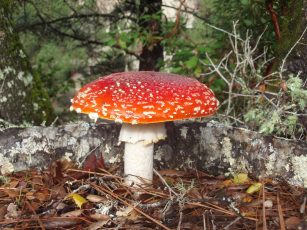
The common name for these mushrooms are Death cap, Destroying angel, and Deadly galerina. A single mushroom can be fatal if eaten although surprisingly there is no harm in handling them. If you know what you are looking for they are fairly easy to identify. If you aren’t a mushroom expert the amanitas may look like just another white gilled mushroom similar to a meadow mushroom or the galerina just another little brown mushroom of which there are many related species of unknown edibility.
A couple years ago on a hike in Fall Creek with the Sierra Club, I saw many beautiful mushrooms. Chanterelle grew in several locations along the trail. Although they were positively identified, collecting in a state park is prohibited so we took pictures only. We found huge clumps of honey mushrooms that are often eaten but sometimes cause stomach upset. Why a person would consume this variety is beyond me but sure enough, there’s a recipe in my book for fresh swordfish steak smothered with a mixture of sliced shitake, oyster and honey mushrooms.
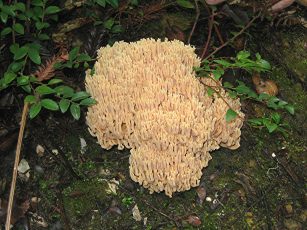
We came across an impressive Coral fungi emerging from the forest duff. They are quite distinctive looking and many are edible. My Hip Pocket Guide to Western Mushrooms by David Aurora, however, states that even this unique looking family of fungi can be hard to identify. Many are mildly poisonous while some are edible.
So if it’s difficult to correctly identify edible mushrooms in the wild can you grow them yourself? It’s hard to achieve this in the back yard as fungi spores have a mind of their own as to where they want to live. Plus our temperate rain forest has no shortage of diverse mushroom types all spreading their own spores.
Several years ago at the Fungus Fair in Santa Cruz I purchased a package of oyster mushroom dowel plugs used to inoculate freshly cut heart wood. This method is not as easy as it sounds as you can’t use logs that are laying around in the forest because they may already be contaminated with other kinds of fungus. After 11 months of care my logs had yet to produce any oyster mushrooms. Undaunted I’ve now got a mushroom kit that consists of a plastic bag of growing medium containing Oyster mycelium. According to the instructions I should be harvesting mature size mushrooms in 2-3 weeks and get 4-5 crops from the kit. I’ll keep you posted.
There are over a thousand beautiful fungi to discover in our area. They live in such lovely places. Get out and enjoy the beauty of mushrooms. There’s fungus among us.

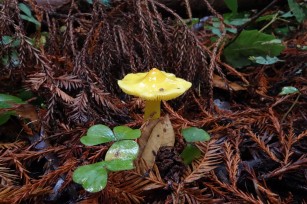
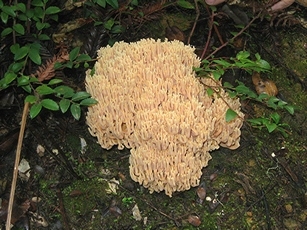 ild mushrooms growing in this area that are edible there are just as many that are poisonous. Mistakenly ingesting them can cause death or liver damage so severe that a transplant would be needed for you to survive. In November, Santa Cruz County received the second report of a hospitalized person who became seriously ill after eating mushrooms collected in the La Selva Beach area. According to the press release, both illnesses were probably due to the mushroom Amanita phalloides. Other common poisonous mushrooms found throughout the county are Amanita ocreata and Galerina autumnalis.
ild mushrooms growing in this area that are edible there are just as many that are poisonous. Mistakenly ingesting them can cause death or liver damage so severe that a transplant would be needed for you to survive. In November, Santa Cruz County received the second report of a hospitalized person who became seriously ill after eating mushrooms collected in the La Selva Beach area. According to the press release, both illnesses were probably due to the mushroom Amanita phalloides. Other common poisonous mushrooms found throughout the county are Amanita ocreata and Galerina autumnalis.